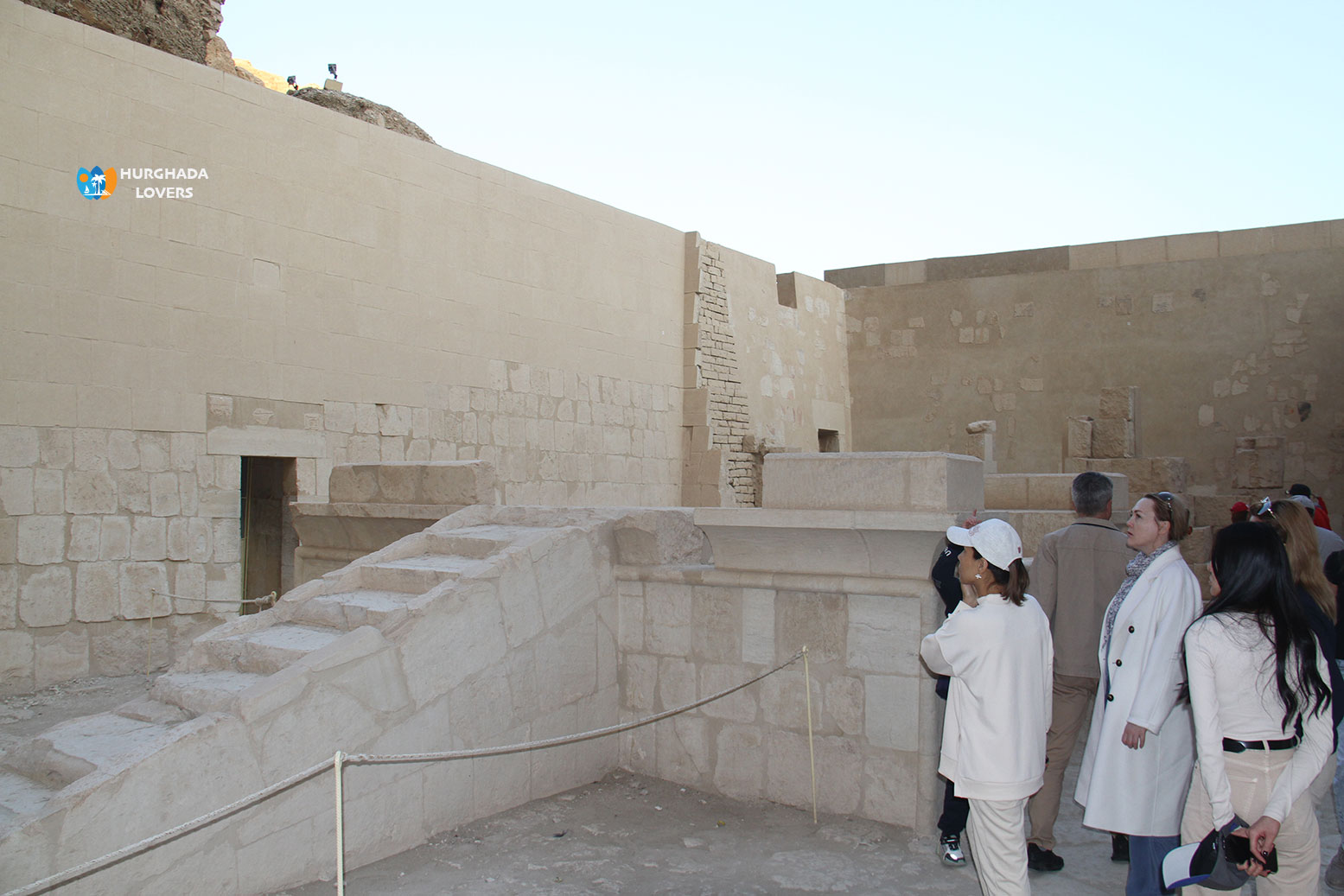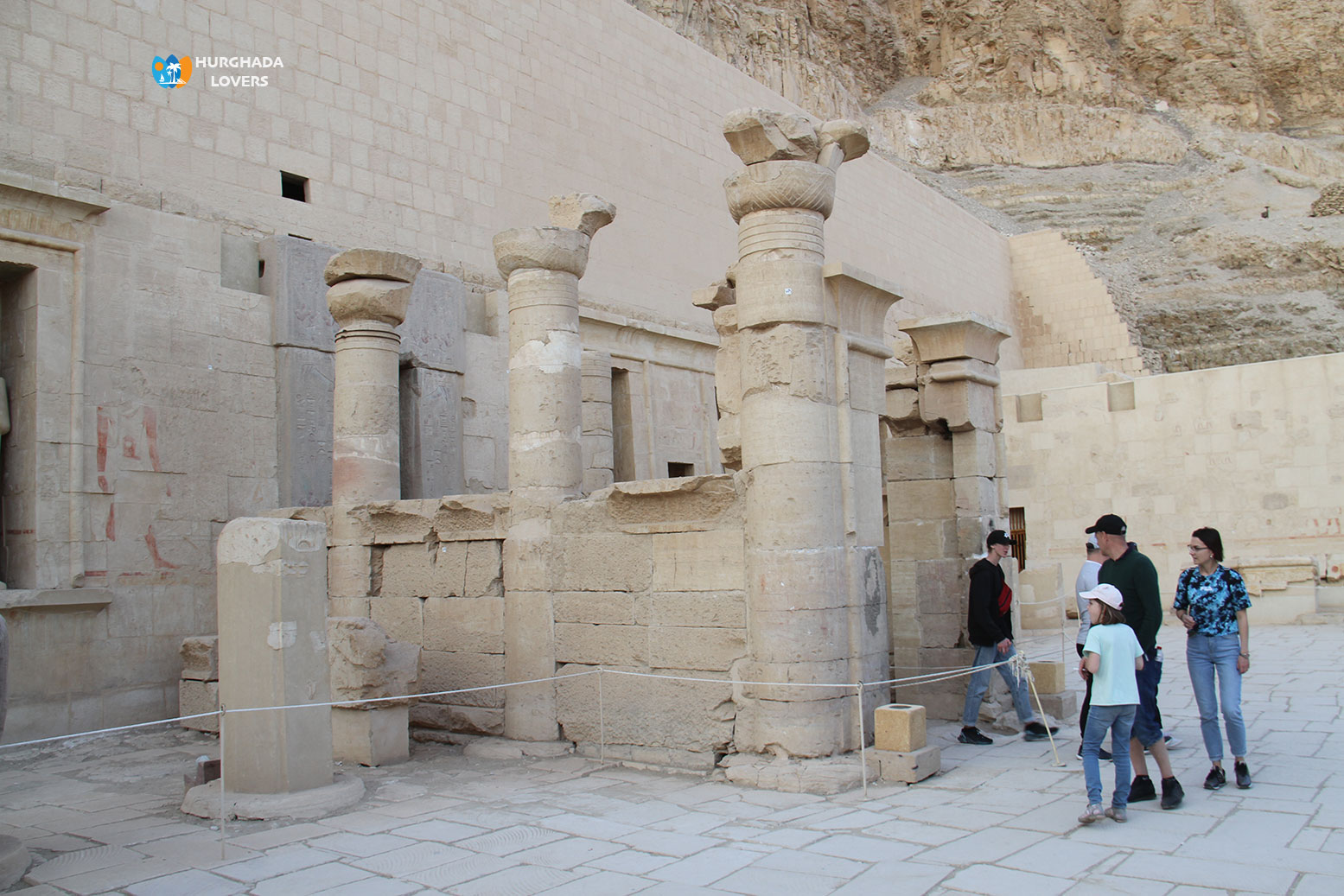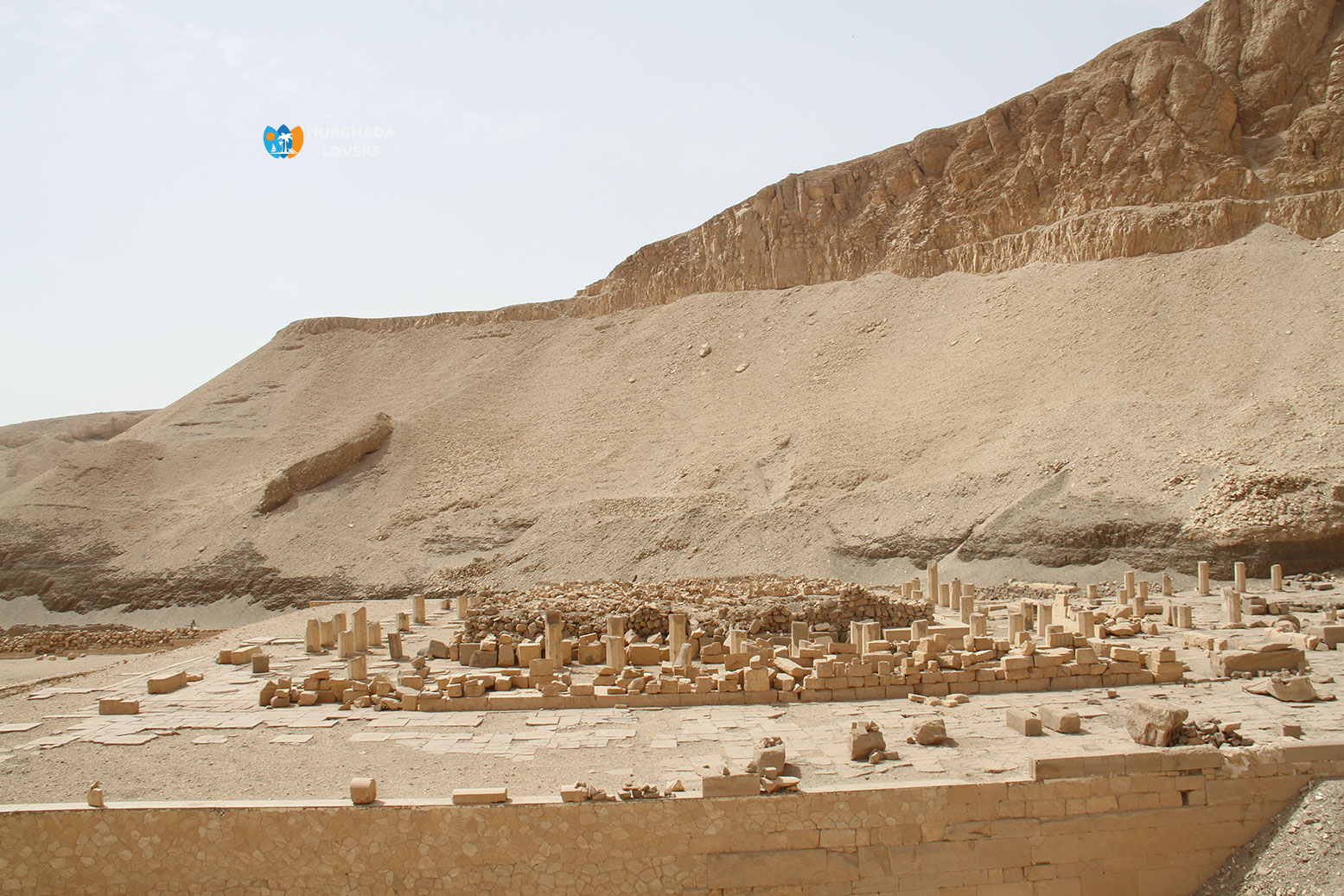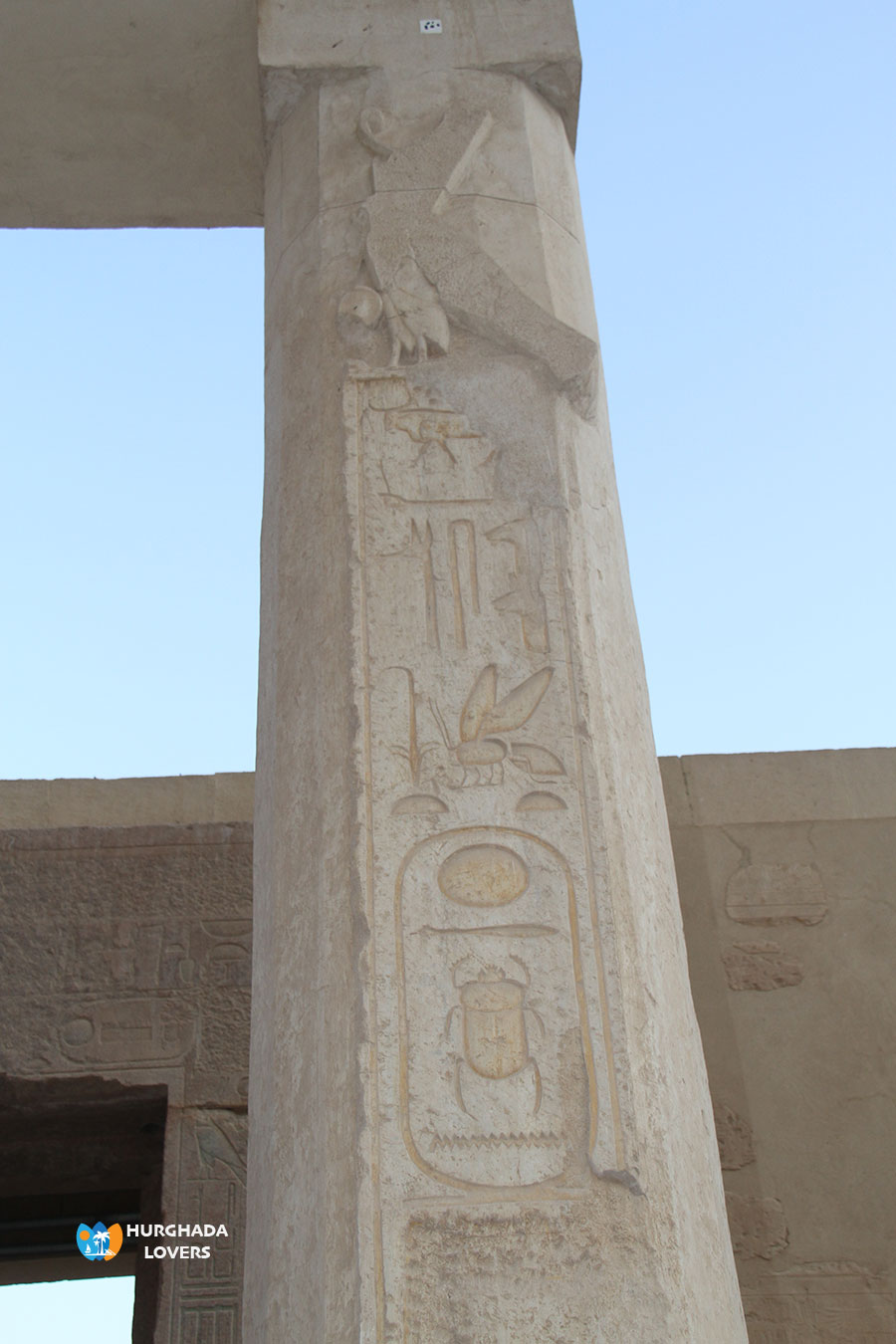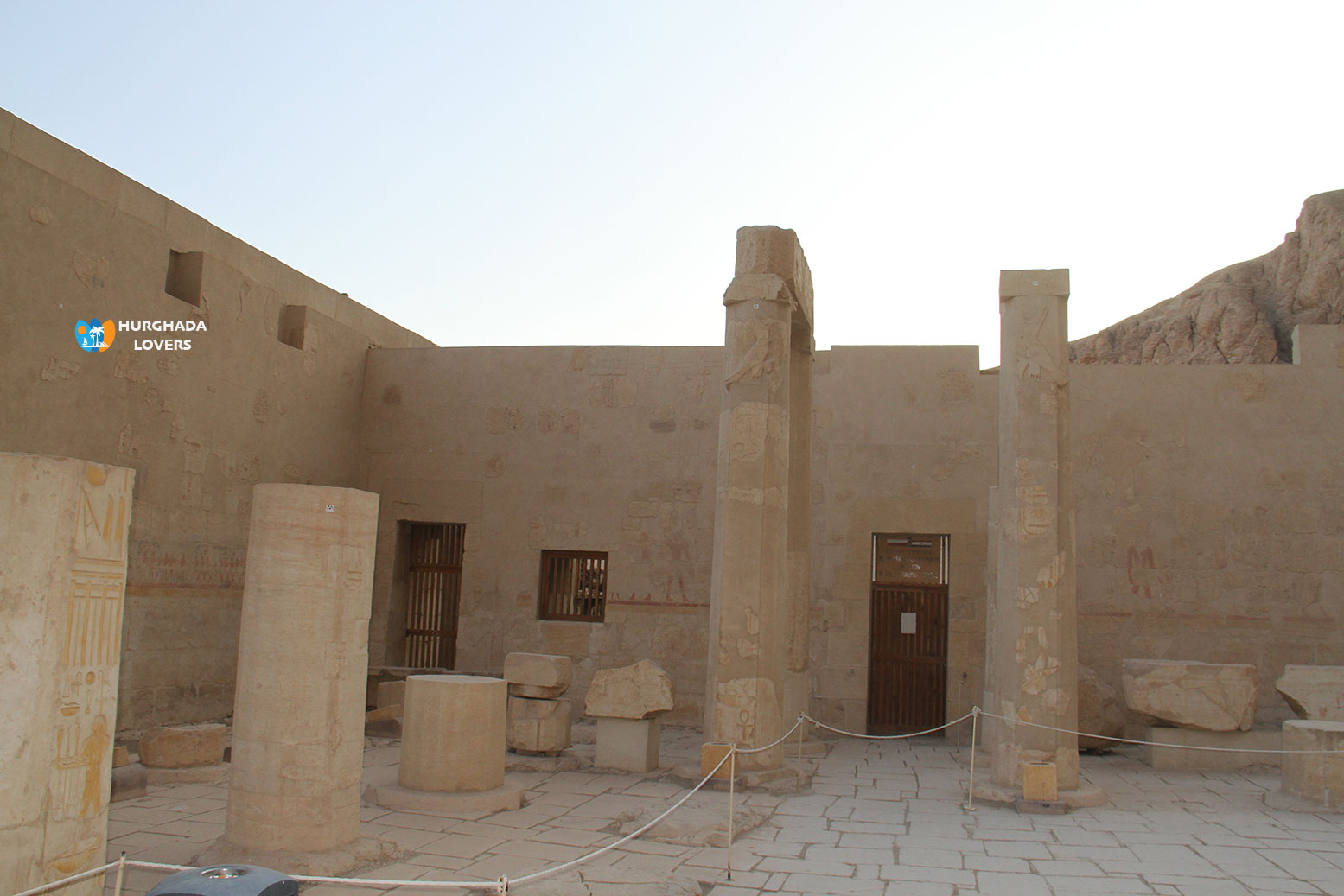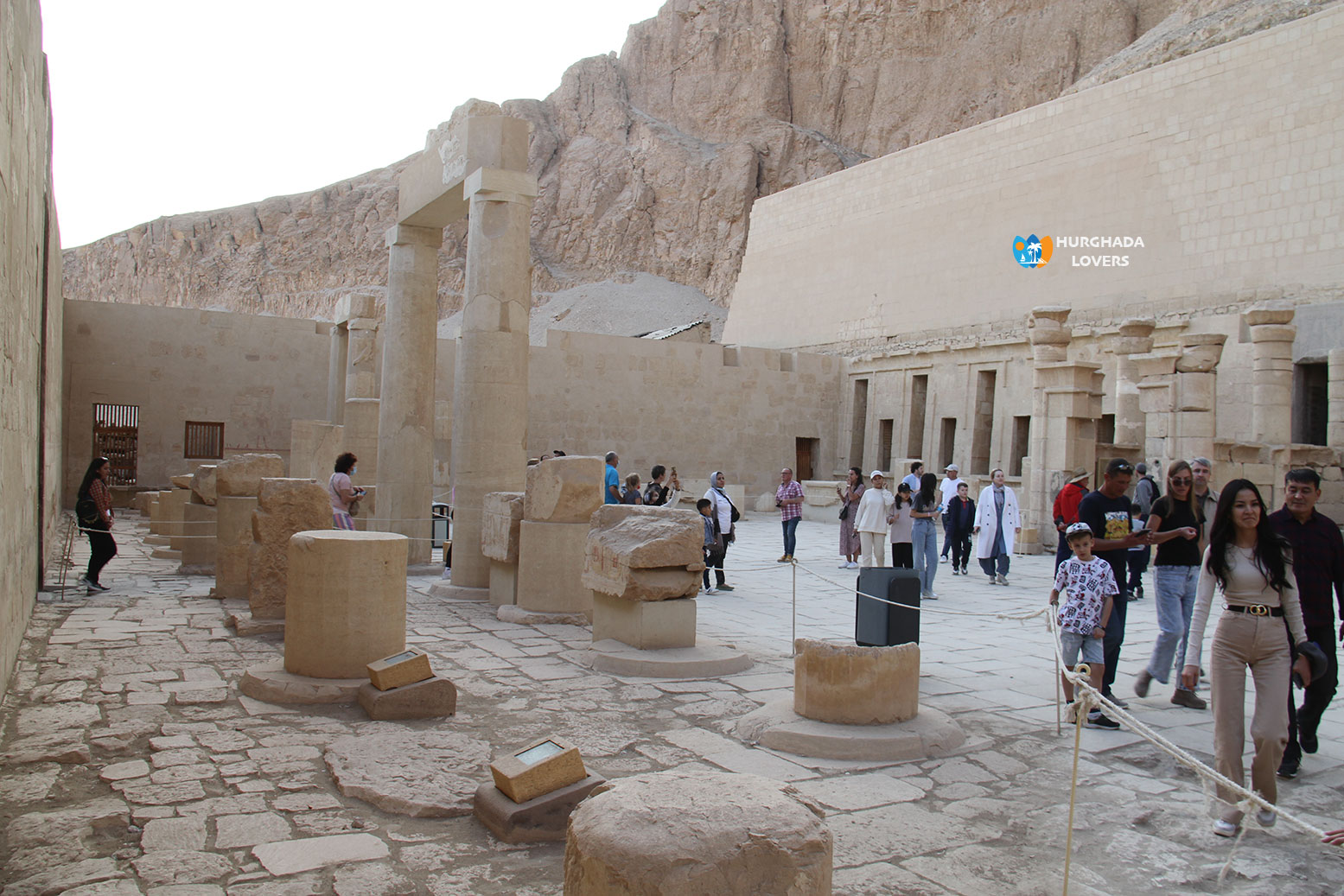Temple of Hatshepsut in Deir El Bahari Luxor Egypt | Discover Facts, Architecture, History , Design from inside, location, Wall Painting and more…
Discover Secrets of building the most important funerary and Mortuary Temples and pharaonic Egyptian Monuments in the ancient city of Luxor.
Hurghada lovers Offer Luxury Hurghada to Luxor Tours | El Gouna to Luxor Tours | Makadi bay to Luxor Tours | Sahl Hasheesh to Luxor Tours | Soma bay to Luxor Tours.
Mortuary Temple of Hatshepsut
- Opening date: November 1997
- Temple Type: Funerary Temple
- Pharaonic dynasty: 18th
- Temple Age: 3500 years
- Location: the left bank of the Nile in front of the city of Luxor
- Duration of construction of the Mortuary Temple of Hatshepsut: 15 years
- Kings buried in the temple: Senenmout, Herihour
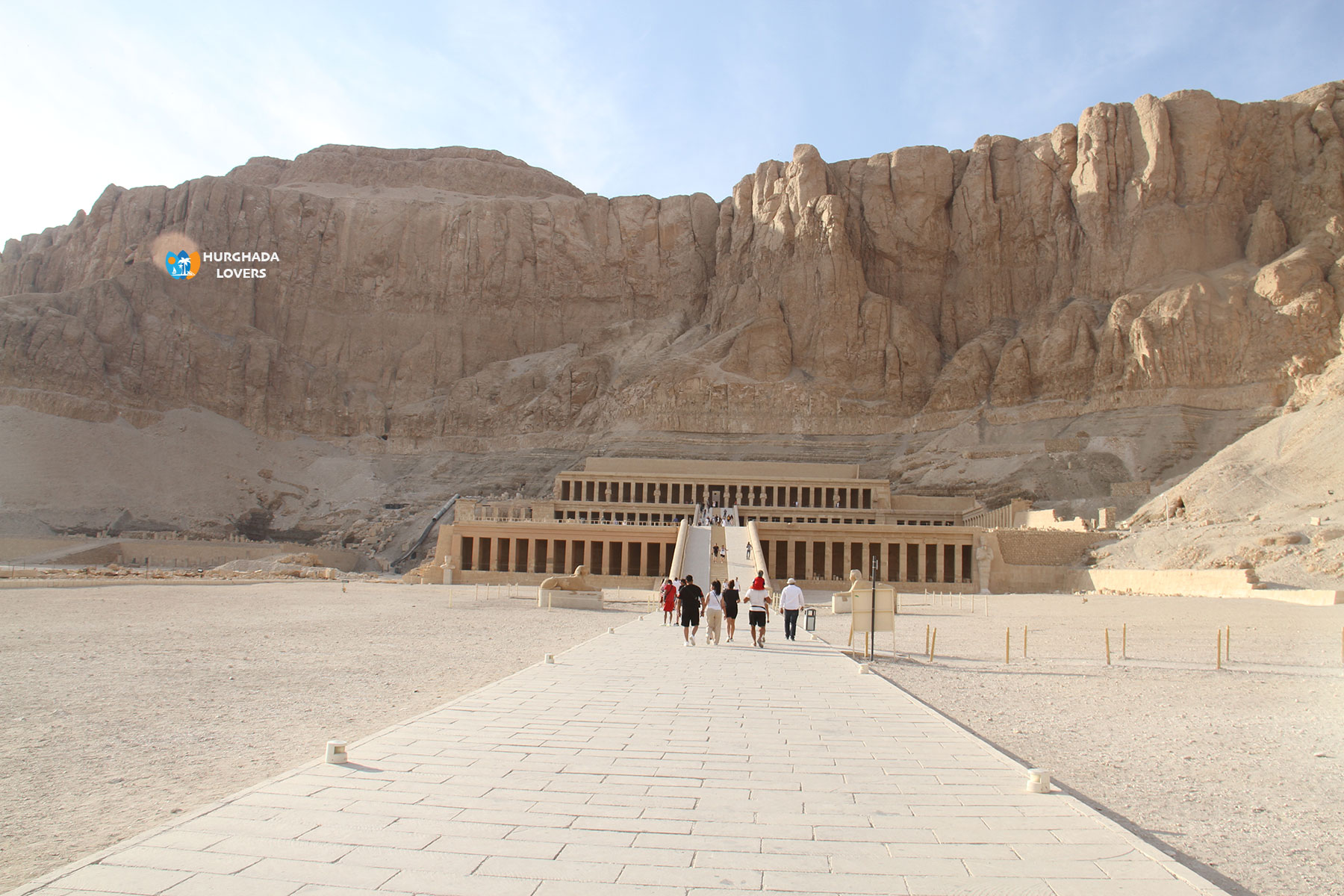
Secrets of the construction of the Mortuary Temple of Hatshepsut in Luxor:
In the rocky hills of the monastery, part of it was dedicated to the worship of the God Amun “The Egyptian Gods“. Its plan is one of the most beautiful realized in the history of the Architecture in ancient Egypt, built by the Queen’s Minister Senenmut “Egyptian Pharaohs“and perhaps inspired by a Tomb of King Amenhotep II from the time of the Middle Kingdom.
It consists of three apartments on different levels and is connected by an ascending ramp that ends on the next floor, and on both sides of the ramp are islands that in turn divide into two parts a corridor and a chapel. The top floor ends with the body of the mountain in the heart of the engraved saint of holies “Holy of Holies” to know more about Ancient Egypt Civilization.
In the site of Deir El Bahari, learn about the history of the construction of the most important Pharaonic Egyptian Temples located in Luxor, Egypt, and the secrets of the Pharaohs kings you did not know.
Queen Hatshepsut is one of the most famous queens of ancient Egyptian civilization and she is the only woman to rule Egypt in Pharaonic times as Pharaoh.
The word Hat mean the elite, the word “shepsut” means the noble ladies, that is to say the elite of the noble ladies and this nom was chosen by the High Priest of Amun after consultation with his mother Queen Ahmose Nefertar, in addition the temple was called “Djesser Djesserou” which means the most majestic of the majestic.
Queen Hatshepsut was interested in building the temple and transporting all her belongings to the temple, which was to be the “Paradise of the God Amun”, which was also an Funerary beliefs in ancient Egypt, but established other places fora great goddess, God Hathor and in addition God Anubis the guardian god of the Necropolis for the purpose of building a funerary temple for her and her parents.
An archaeologist Egyptology explained that the reason for the construction of the Mortuary Temple of Hatshepsut to ensure the queen’s family members her right to the throne, where there were religious conflicts following the King Akhenaton Revolution and differences between her right to the throne of Egypt in the Eighteenth Dynasty that ruled Egypt at the time to know more about Revolutions in Ancient Egypt.
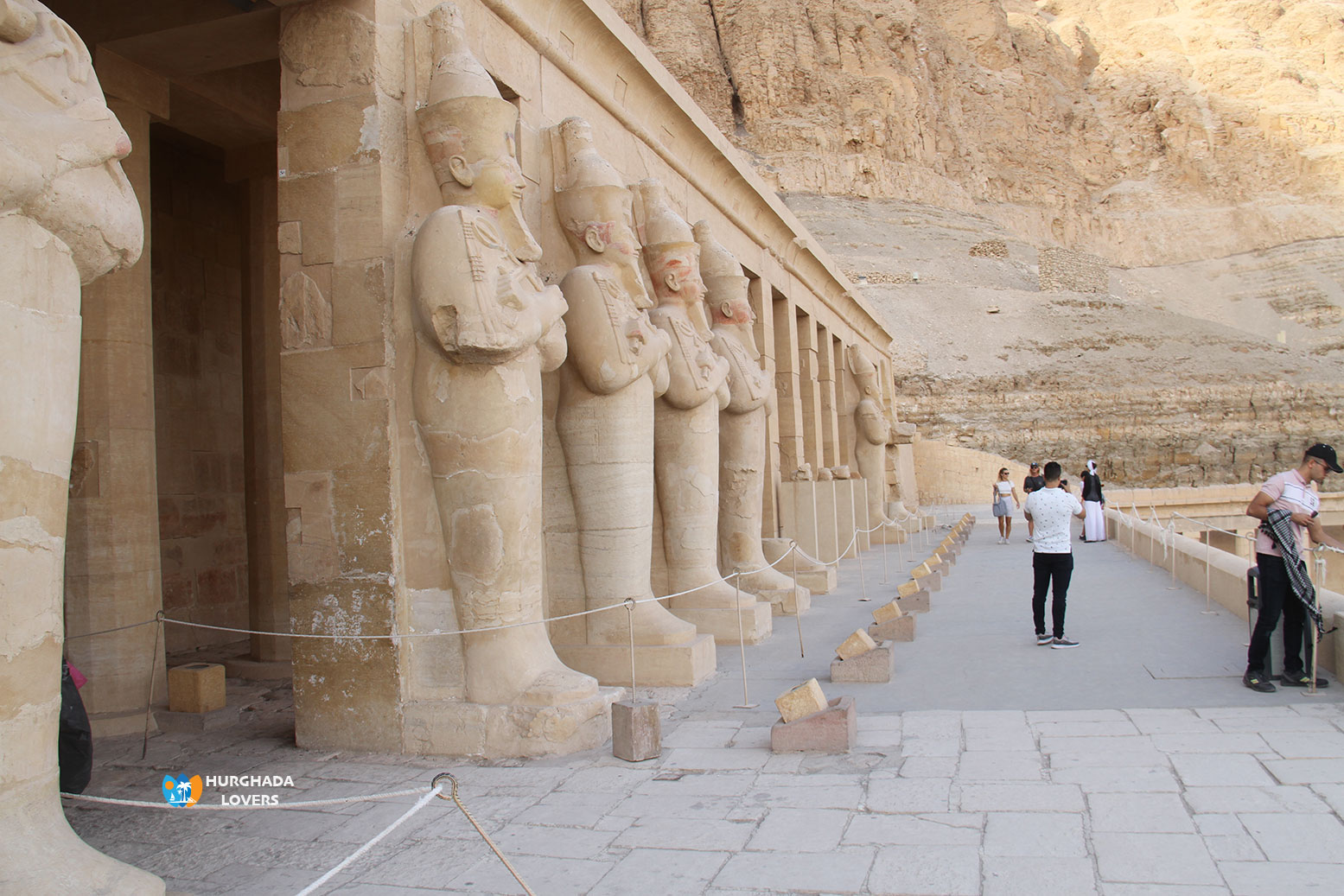
Hatshepsut Temple Inside
The Mortuary Temple of Hatshepsut was different from the current situation, with many monuments destroyed as a result of the passage of time, erosion and climate. Where you could reach the Mortuary Temple of Hatshepsut from the Nile Valley through the Avenue of Sphinxes “Karnak Temple” who guarded the Temple and through a large gate in front of which there were two Myrrh trees on the sides.
The ancient Egyptians considered this type of tree sacred in the Pharaonic Ancient Egyptian Religion, which was known throughout the history of Anubis and Bata to and circulated among people in Pharaonic times.
Coming out of the large gate, there was a large group of palm trees and pharaonic Papyrus plants, but they were largely destroyed, but there are still traces of them so far.
On the west side of the courtyard, you’ll find covered salles on two rows of huge columns, where you’ll find that the room on the north side is largely damaged with remains of a pharaonic bird-hunting view and inscriptions, while the room on the south side contains clear pharaonic inscriptions so far to know more about Sculpture in Ancient Egypt and Art in Ancient Egypt.
There are 22 square columns in the courtyard, in addition to 4 columns next to the north room “the room of the divine birth of the queen”, where the inscriptions for the stage of birth were painted with great precision by artists of the Pharaonic era.
When you then head south towards the South Hall, you will find the Chapel of the Goddess Hathor opposite that of Anubis, which is located at the end of the Divine Birth Hall.
Quite to the left (south side) you will find a construction that has lost its ceiling where you will find in the first hall 4 square columns with hathoriccapitals, behind which two rows of columns, composed of 18 sides and 4 other square columns to now more about Agriculture in Ancient Egypt.
In the second foyer you will find 3 round columns with hathor crowns and 16-sided columns as well as pharaonic drawings and inscriptions on the wall on both sides of the inner section of the hall.
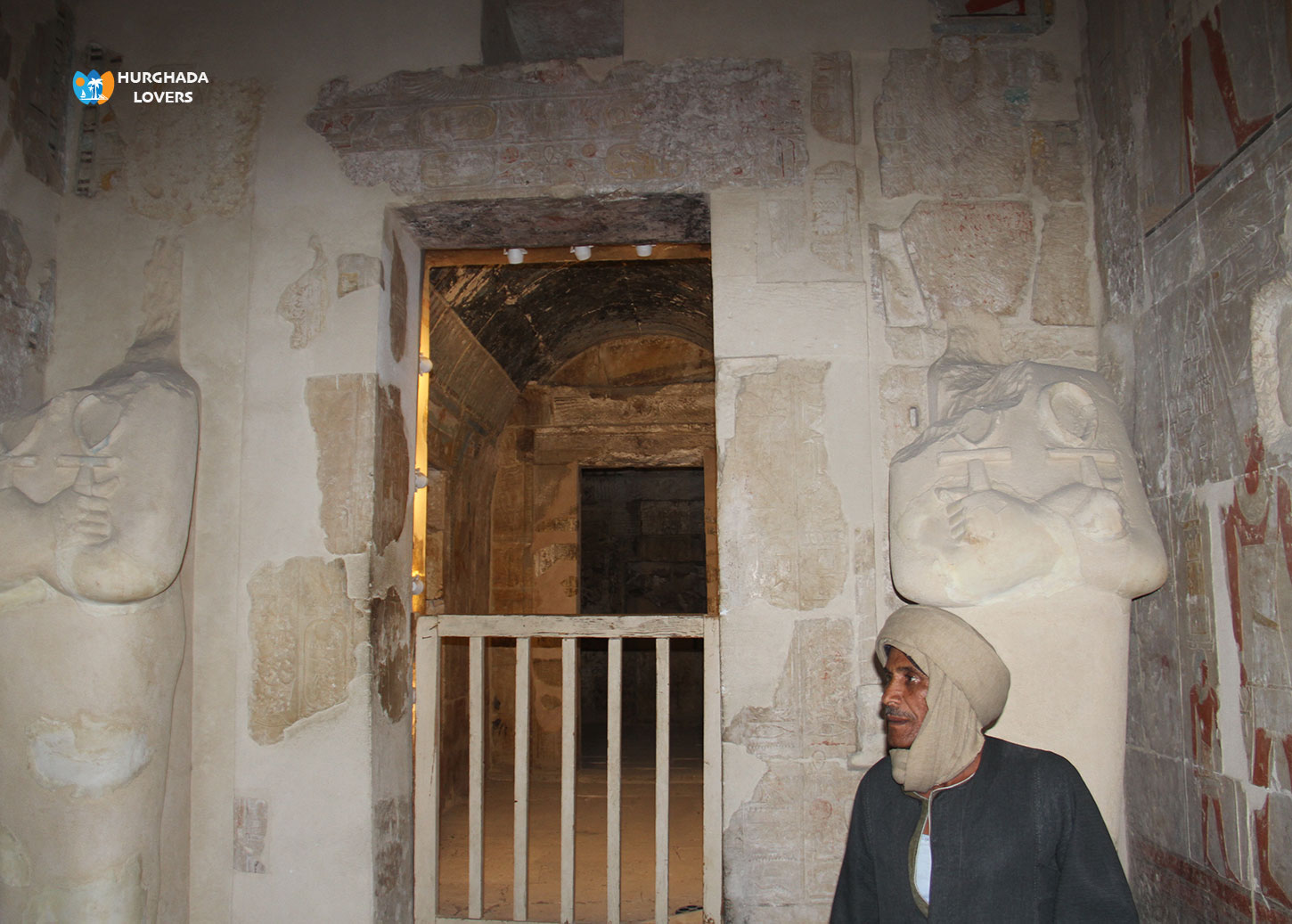
Halls of the Mortuary Temple of Hatshepsut:
Compartment of the main structure:
It contains two square columns, then an open-air courtyard that leads you to 4 small structures and pharaonic drawings on the ceiling of the room representing the stars in the sky in unique colors, as well as pharaonic inscriptions of Queen Hatshepsut and King Thutmose III as they offer offerings to Hathor to know more about Religious beliefs in the civilization of ancient Egypt.
Then you will go to the outer Mortuary Temple of Hatshepsut, you will find drawings of Queen Hatshepsut offerings to the holy cow representing Hathor among the pharaohs “The Book of the Heavenly Cow“, which is on the sacred boat, in addition to the drawings in front of the queen, Hathor’s son stands “Ihyi” waving the sistre to know more about Religious rituals in the Pharaonic.
Now, heading inward with vaulted ceiling, you will find drawings of Queen Hatshepsut who is suckled by the sacred cow, and Amun stands in front of the queen’s head, then engraved with Hathor and Amon as they raise the sign of life in the nose of Queen Hatshepsut.
When you return to the middle courtyard and then descend the slope to reach the third floor, you will find the tomb of Queen Nefero of the 11th Dynasty, where the cemetery and sarcophagus were discovered in 1924 and 1925 under the hands of the mission of archaeologists from the Metropolitan Museum Of Arts in New York.
When you reach the upper courtyard of the temple of Queen Hatshepsut, a first row of 22 columns will be attributed to the statues of Queen Hatshepsut in the form of God Osiris, but King Thutmose III turned them into square columns, in addition to a row opposite to 16-sided columns, but unfortunately the remains were completely destroyed and became ruins until today.
When you walk out of the granite door with cartouches of the King Thutmose III, you will find a large courtyard or with the ruins of two columns but badly damaged , as well as a set of niches.
We start going out in the right direction and enter through a door in a northeasterly direction to reach a small room with three columns with 16 sides, where you will find pharaonic inscriptions of Queen Hatshepsut standing between the God Ra Hor Ahty and the god Amun, other drawings on the back wall representing Amon but it is not clear due to the conditions of erosion and climate over the course of the temps.
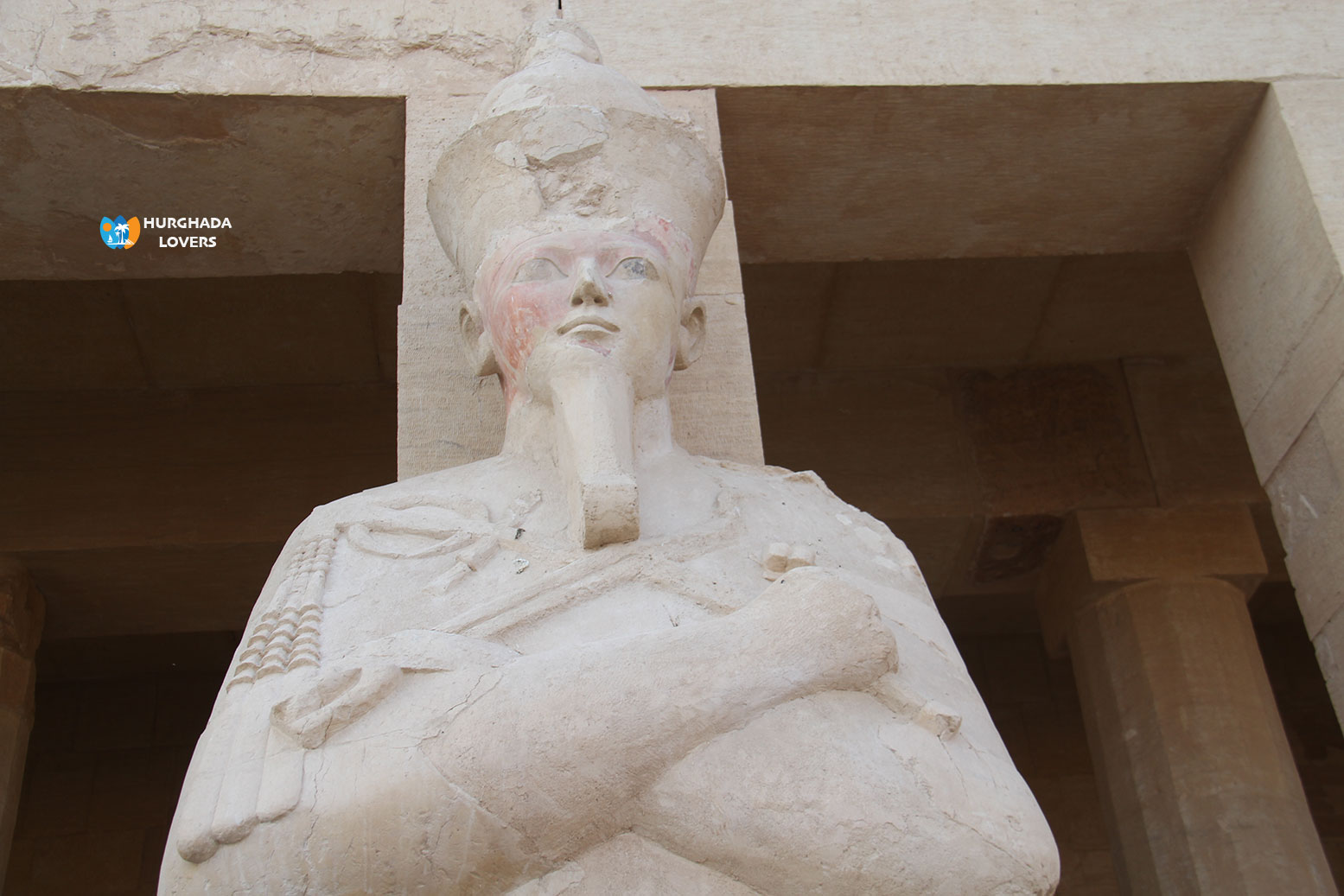
Altar room:
In the center of this room there is a large limestone altar dedicated to the god Her em Akhet as well as on a small funerary structure dedicated to the worship of the ancestors of Queen Hatshepsut.
When you have finished the altar room, we head straight west through a door to the Amun Chamber or the Northwest Chamber of Obsolescence, where we find pharaonic drawings of Queen Hatshepsut offering two boats to Amun Mine, but the inscriptions have been largely worn out, including the inscriptions of King Thutmose III .
There are rooms on the left side of the superior court, but they are largely dilapidated, and there are scenes of offering presentations as well as inscriptions for the procession of servants when they bring offerings.
Then we head southwest and find a door leading you to a hall of the god Amon Ra, and you will find the Mortuary Temple of Hatshepsut inscriptions of Queen Hatshepsut offering to Amon Min and Amon Ra.
When you head back to the temple, you’ll find niches in the ouest wall and pharaonic inscriptions of Queen Hatshepsut and kings offering offering offerings before the God according to their once beliefs.
The entrance to the great temple is designed in the form of a granite door in front of which a gallery from the Ptolemaic Kingdom, and inside the temple you will find 3 rooms, where you will find on the south wall engraved for the condescence of the temple and on the opposite wall engraved with inscriptions of Queen Hatshepsut and King Thutmose III and the Order of Princess Neferure presented a boat behind that of King Thutmose I, the reine Ahmos and Princess Pett Nefero.
A hideout located 1,000 meters south of the temple of Deir El Bahari was discovered in 1881 on a large collection of royal mummies, as well as a mass cemetery with 163 mummies of priests in 1891 located north of the lower courtyard of the temple of Queen Hatshepsut.
A tomb carved into the rock by Queen Meritamen, daughter of King Thutmose III, and Queen Merit Ra’a, was discovered by the The Metropolitan Museum of Art mission in 1929, where a well will be installed and nearby will find a tomb for Princess Antioni, daughter of King Pinegem of the Twenty-first Dynasty.
A huge The Coffins in Ancient Egypt was discovered near the well of the Queen of Hatshepsut, up to 10 feet high, and is in the burial chamber so far.
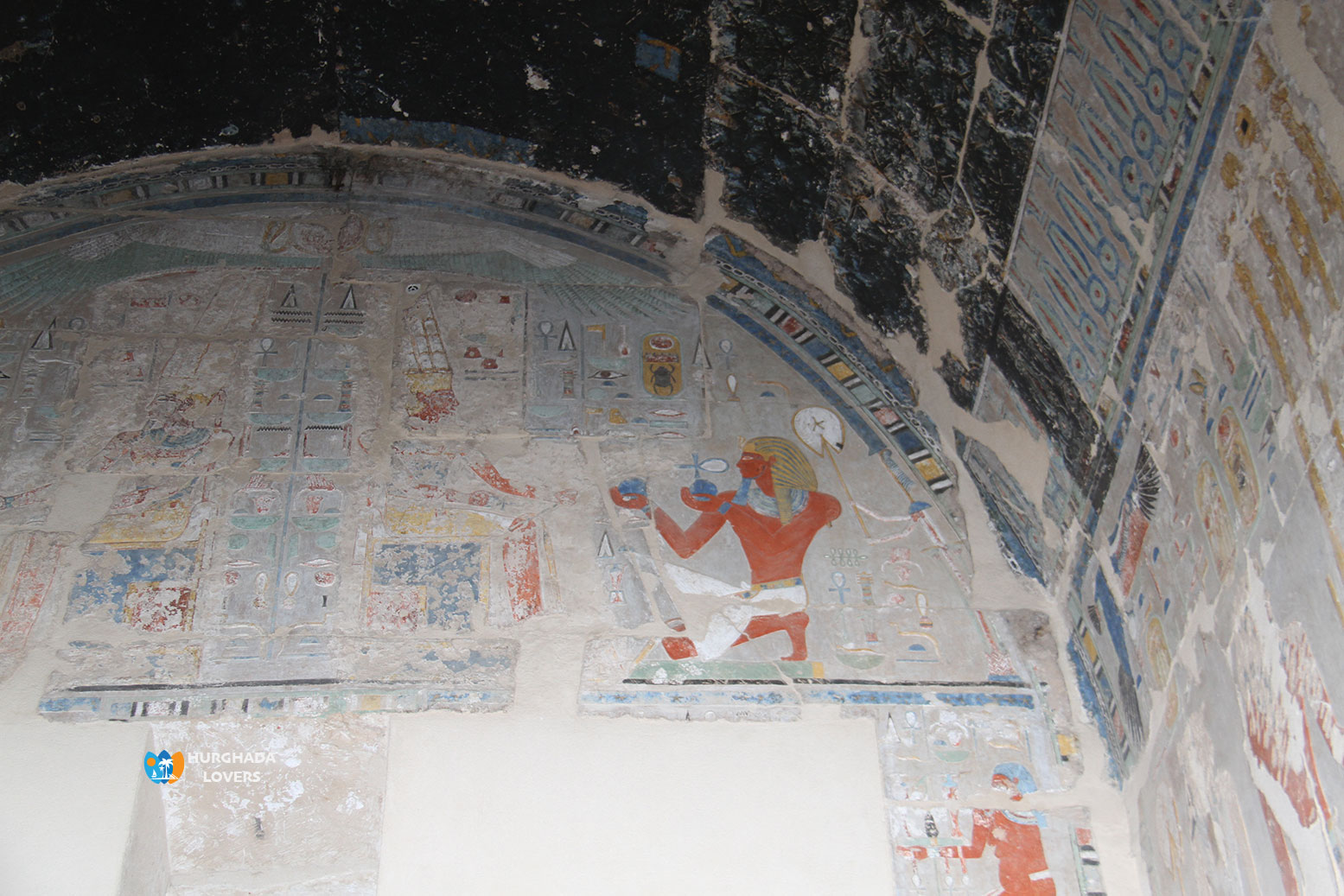
Pharaonic drawings and famous inscriptions for the temple:
- A story that shows that Queen Hatshepsut is not the natural daughter of her father, but the daughter of the god Amon Ra, who slept with Queen Ahmose Nefertari as was a long-held belief of the pharaohs to know more about The Social Phenomena of Ancient Egypt.
- Pharaonic inscription for the cruise sent by Queen Hatshepsut to Somalia now to bring goods, incense and spices to know more about Trade in Ancient Egypt.
- Inscriptions showing how to move the two Obelisks from Aswan to Luxor.
- The balcony system is engraved with the design of the Pharaonic architect Senenmout, one of the most famous architects of the time of the pharaohs, who made a complete planning of a temple and was close to Queen Hatshepsut to know more about Architecture in ancient Egypt.
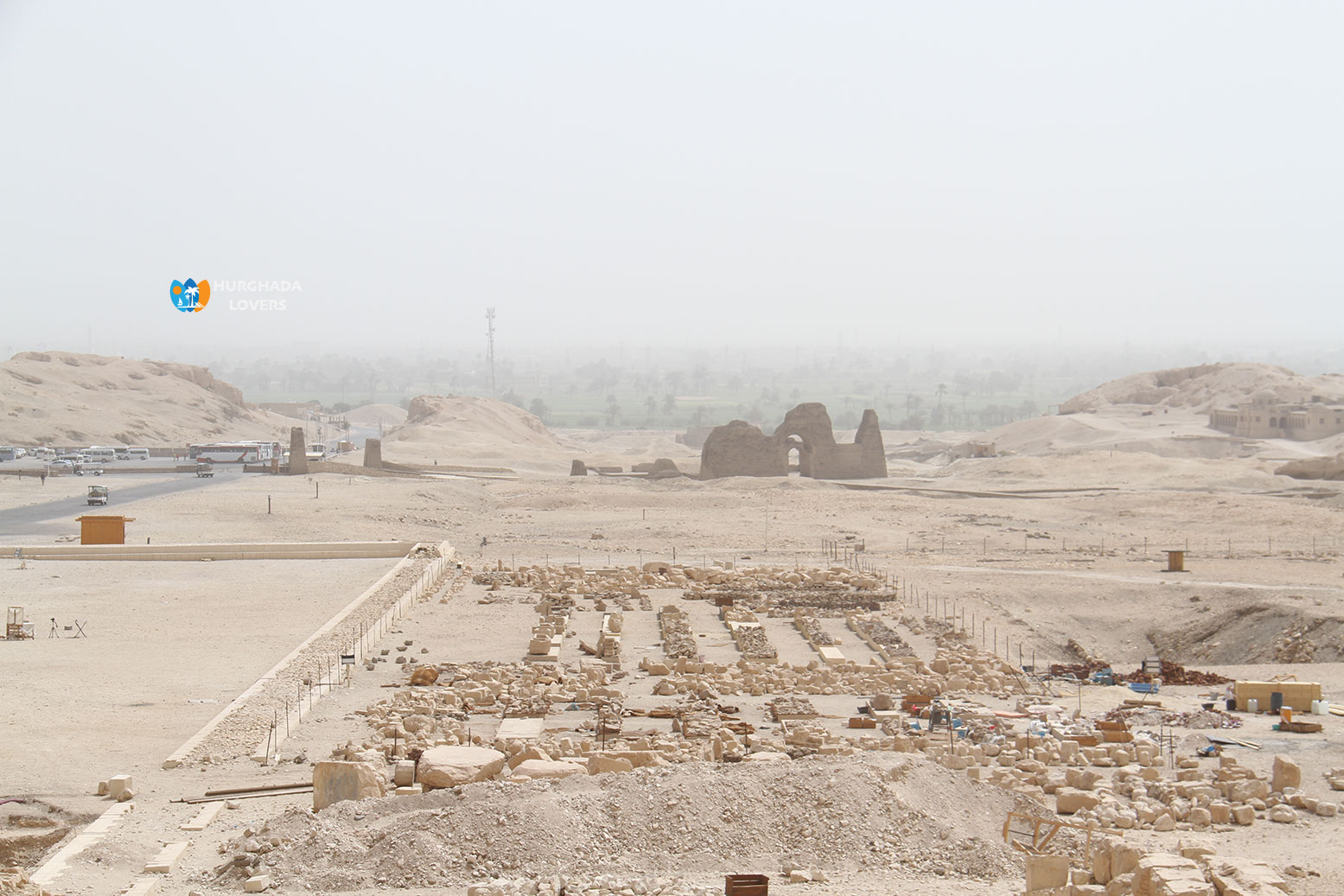
Funerary temples:
Mortuary Temple of Hatshepsut appeared in various regions and were dedicated to the worship of the gods, the temple surrounded by columns was commonly used, and columns cited in the form of the palm tree abounded, and one of the most famous funerary temples found at that time was the Funerary temple of Merenptah “The king Merenptah” south of that of Hatshepsut still on the very site of Deir El Bahari and has two roofs one above the other topped by a pyramidal building “The Secrets of Pyramid Construction“.
There is the funerary temple of Amenophis III in Howara, which has a very large number of overlapping pieces, which the Greeks called (Labyrinth),and Herodotus (the great Greek historian) said that it surpassed the size of the pyramids.
Funerary temples were intended for funeral rituals and priests, and were not intended for worship, and took place in which the funeral rituals of kings and princes took place and their biography, education and royal descendants were written without mentioning their achievements, the most famous of which was in the Middle Kingdom the Pharaonic Egyptian Tombs and funerary temples in the area of Beni Hassan Montou Hetep II in Deir al-Bahri and were built in the central state around the pyramids.
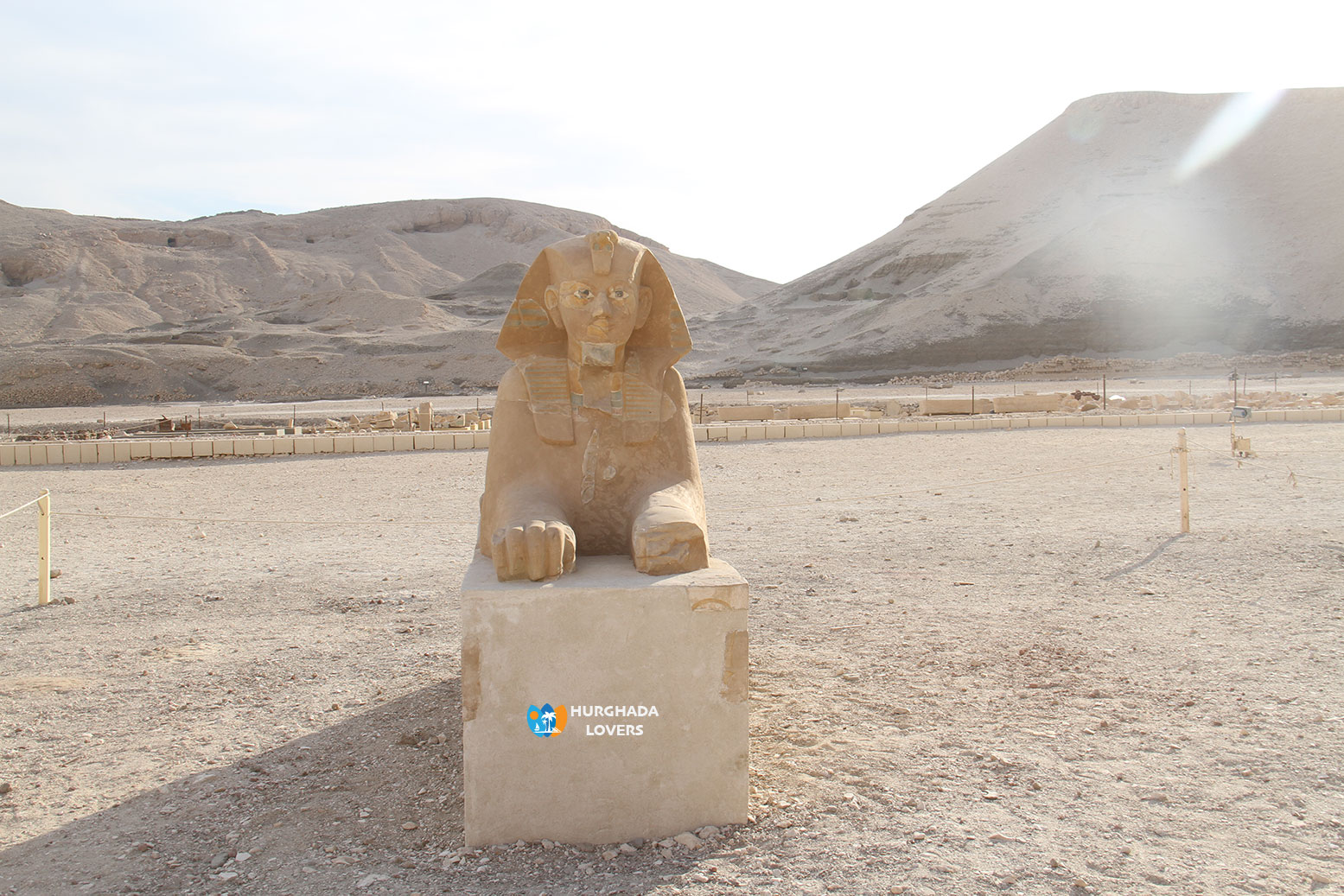
About the Queen: Maat Kara Hatshepsut
The third among the kings of the 18th dynasty, Thutmose I, married his sister Ahmose, who gave birth to three children: Hatshepsut and another daughter, and Prince Thutmose II, and as soon as he became king, the prince followed the prevailing custom and married his sister Hatshepsut, who had only daughters, and had another wife, Isis, of unknown origin, who gave birth to a son, Thutmose III.
After his death after a reign of no more than six years, the prince had a young child who could not rule, and not everyone was ready to see him as heir to the throne.
She was the royal daughter and royal wife Hatshepsut, over whom they recognized her rights, and she survived as soon as possible after her husband’s death while taking her titles of queen.
His name Horus is Ousseret Kao es, powerful are his spirits.
Its name Nebti: oudjat Renpet, that is, the one that has the flourishing years, and its name Horus on gold is Neteri Kha’ou which means Divines are its manifestations.
They used his royal name more than his birth name, Maat Ka Ra meaning the spirit of the cosmic order of Ra.
She used to serve her ambition with theoretical skills invented by the priests of Amun, and tried to suggest thather father Thutmose I had chosen her to rule, but that was not enough.
On the walls of the Temple of Deir El Bahari, Hatshepsut told the holy story of his divine birth Amon Ra, king of the gods, contacted the gods of the Great Eneade, all to give Egypt a king and took the form of the reigning king Thutmose I and entered the queen’s house at night and the fruit of this meeting was the daughter of Amun Hatshepsut.
The gods took care of the Queen Mother, the child, who in turn was trained by the God Khnum on the wheel of the father: this God and the God Heqet came with the right to help Queen Ahmose, and the sacred cow Hathor sucked her with her milk. Only infidels will oppose his law, which is protected by the gods.
Let us make sure that some of these opponents would have demonstrated against her if the Queen had not gathered around her the highest statesmen and entrusted them with the great tasks and actions of the state: Hapou Seneb, the first prophet of Amun, Djehouti Ousser and Mine Nekhet, the supervisor of the works.
He directed the cutting of stones, the transport and construction of granite obelisks, the construction of the sacred enclosure, the management of the work of jewelers and micro-ivory and the supervision of the construction of the chapels to know more about Industry in ancient Egypt.
Queen Hatshepsut’s relationship with Senenmout:
Among those surrounding the Queen, there was afairly important person,the supervisor of the business supervisors and the royal chancellor: Senenmout.
The names of Senenmuut and the Queen together are mentioned on many monuments, for example, on a rock in Aswan, on a stone chapel and on the foundations of a chapel in the Mortuary Temple of Hatshepsut of Deir al-Bahari, and we have not seen them as a king and one of his subjects, but they are closer to a figure of the same social rank, we can dare to say that they are a couple.
The view of Senenmout is engraved in a niche in the chapel of Hathor. Senenmout was the elder brother of Senmen the godfather,ofHatshepsut while Senenmuut became the godfather ofhisdaughter, Nefero Ra. This trust granted for years led him to carve out several magnificent statues representing Senenmout with the daughter of Hatshepsut to know more about The Pharaonic political pyramid.
Statue No. 2291 au Berlin Museum belongs to the kind of statues we call cubicstatues, Senenmout sitting squatting with his knees next to the chin, while the body and its organs are covered with a coat that highlights the head of the royal child under the head of the godfather.
The Egyptian Museum “Museums in Cairo” preserves another statue of Senenmout with the little girl, found by Egyptian art expert Legrain (42116 CG).
The child’s thin body was surrounded by a thin body, which surrounded his large hands, and the child put his finger on his chin. These statues were distinguished by the Queen, and we may be allowed to guess that there is a more intimate relationship between him and the Queen.
For his extraordinary moment, he received permission to carve his tomb in a place adjacent to the Great Temple. At the entrance of one of the rooms there is a sketch drawing also indicates the specificity of his relationship with the queen. The cemetery, on the other hand, is not finished, and Senenmout among the most distinguished figures of the queen’s court in Thebes in a cemetery currently in poor condition (No. 71 El Gourna),and we are surprised that there is a campaign of Aegean offerings

Temple of Hatshepsut Plane / Map:
- Entrance
- First courtyard
- Sphinx Avenue “Number 2 statue of the Queen in the form of the Sphinx.”
- Ramp up to the second level through a runway ladder.
- Obelisks Colonnade “destroyed and no longer exists.”
- Pharaonic inscription on the walls “Fishing, hunting, offering scenes”
- Second courtyard
- in the eastern direction Birth Colonnade
- Anubis Chapel
- In the southwest direction Punt Expedition Colonnade.
- In the southwest direction Hathor Chapel.
- Ramp up to the third level through a step ladder.
- Two Falcons statutes
- Third courtyard.
- Two rows of columns “statues of the god of the dead, Osiris”.
- Entrance to the Queen Hatshepsut open court.
- Sanctuary of Amum.
- right direction Altar room.
- right direction Solar cult chapel.
- left direction Royal cult chapel.
- Enclosure wall for Hatshepsut Temple.
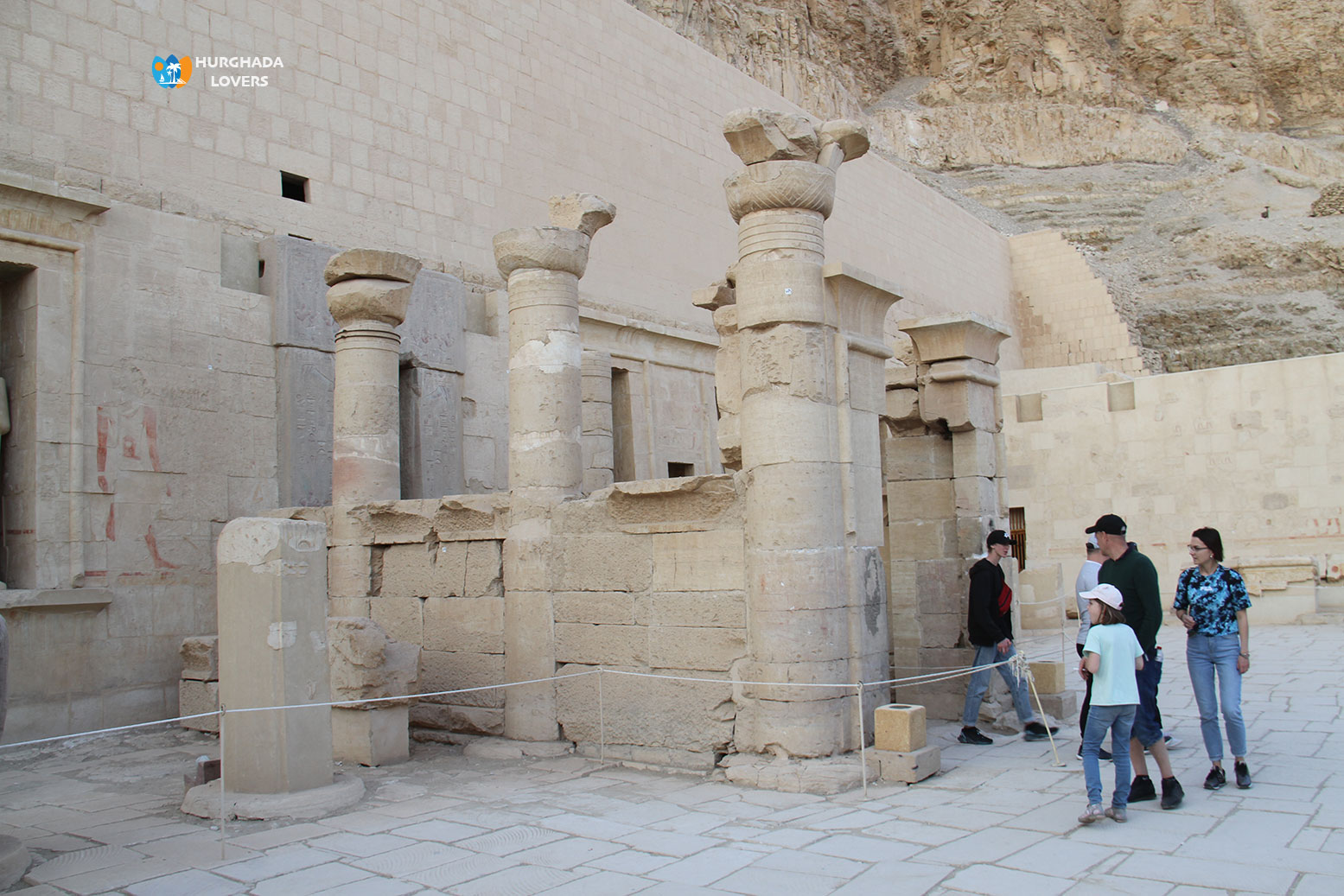
Temple of Hatshepsut Architecture
- The funerary temple was built directly in front of the Nile River in 1473-1458 BC in the Deir el-Bahari area, adjacent to the tombs of the Valley of the Kings, on the western side, in Luxor.
- The most important characteristic of the Temple of Queen Hatshepsut are statues of the god of the dead, Osiris, on the third level of the temple.
- The aim of building the temple is to sanctify Queen Hatshepsut after her death, in addition to the worship of King Thutmose I and religious beliefs and symbols in the ancient Pharaonic civilization of Egypt, namely Hathor, Anubis, Ra Horakhty.
- The temple contains an altar room for slaughtering cows in reverence for the worship of the symbol, the solar Horakhti, the room without a roof, from which you can see the Qurna Mountains around you. A wonderful and amazing sight.
- The temple was built by digging inside the mountain of Deir el-Bahri, and the largest part was built outside.
- The temple was subjected to many means of destruction by the kings of the Pharaohs throughout history, but until now it retains its basic architectural components.
- The temple is designed to shine with the sun’s rays on the 21st or 22nd of December every year.
- The temple was completely restored in 1990 through the Polish Academy of Sciences.
Cartouches and names of the pharaohs were found inside the temple of Queen Hatshepsut, and they are:
- King Ahmose I
- King Thutmose I
- King Seti I
- King Ramses II
- King Ramses IX
- King Ramses II
- King Ramses III
- King Thutmose III
Temple of Hatshepsut Wall Painting
The secret of building the Temple of Queen Hatshepsut, the most famous famous of the Pharaonic Female Pharaoh of Egypt, what are the inner chambers that were discovered, the drawings and inscriptions of the Pharaohs, what are the dates of the visit, the prices of entry tickets, the most important Egyptian Pharaohs kings that influenced and participated in the construction of the Temple of Hatshepsut and more to start visit Tourist Attractions in Luxor.


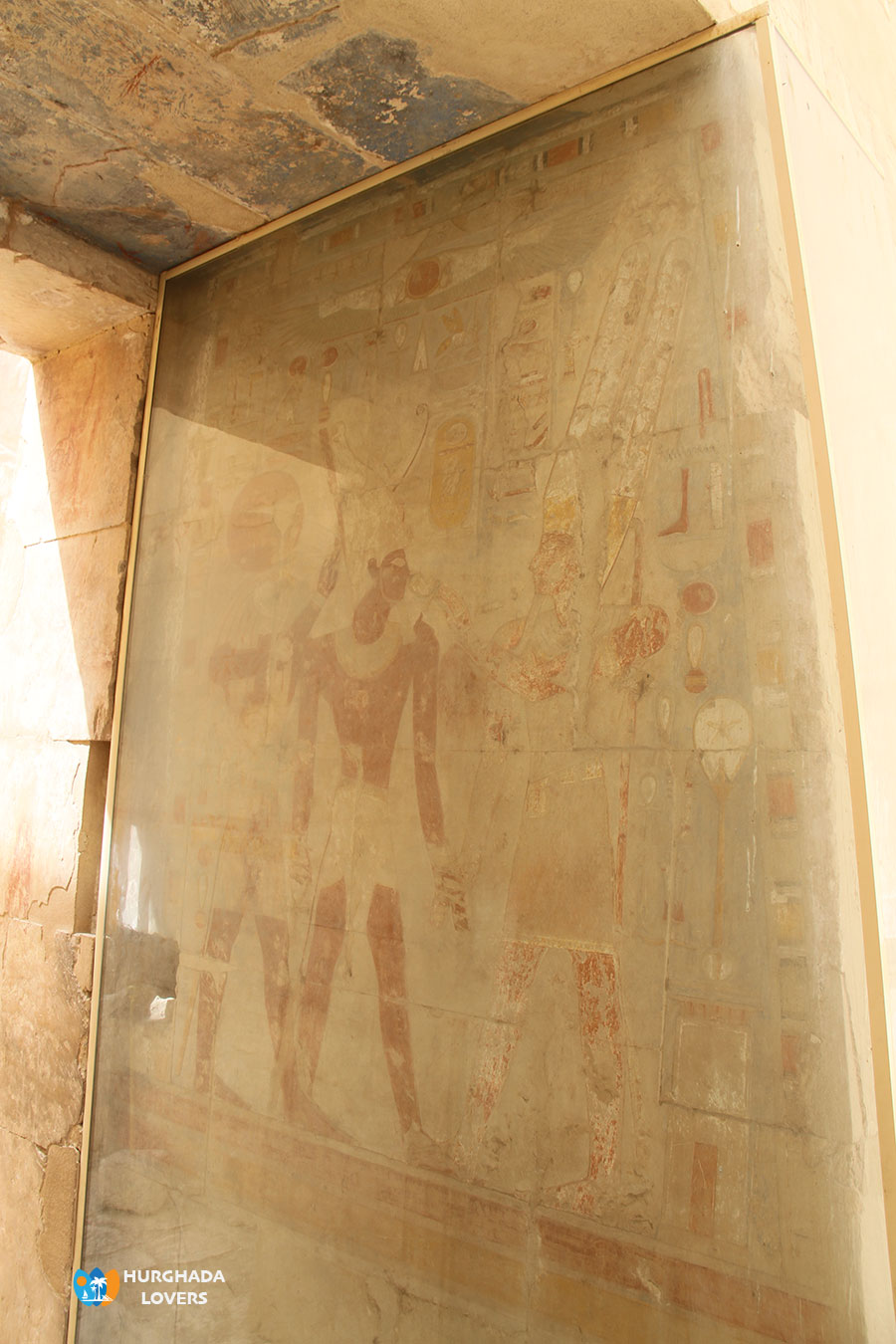
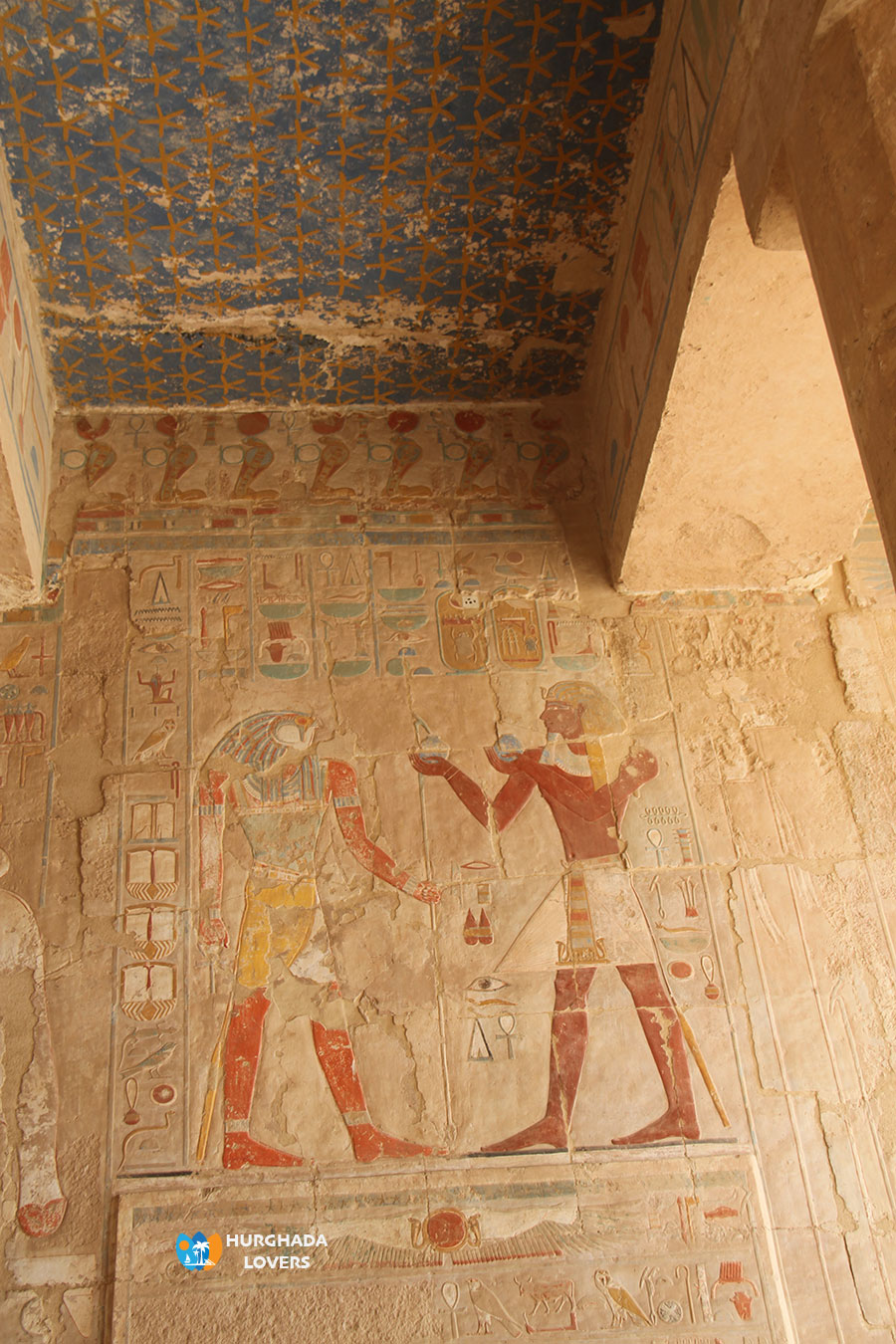

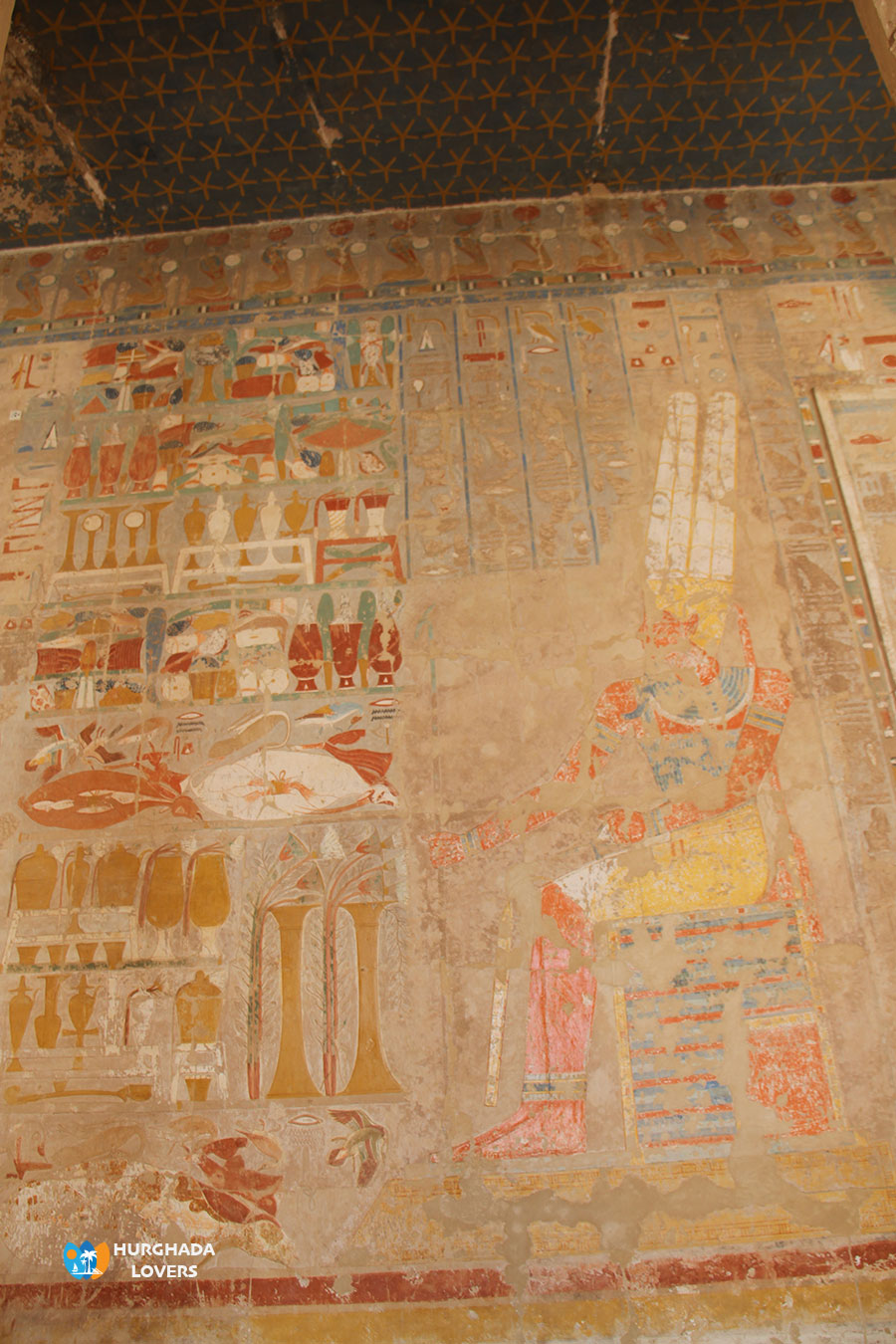
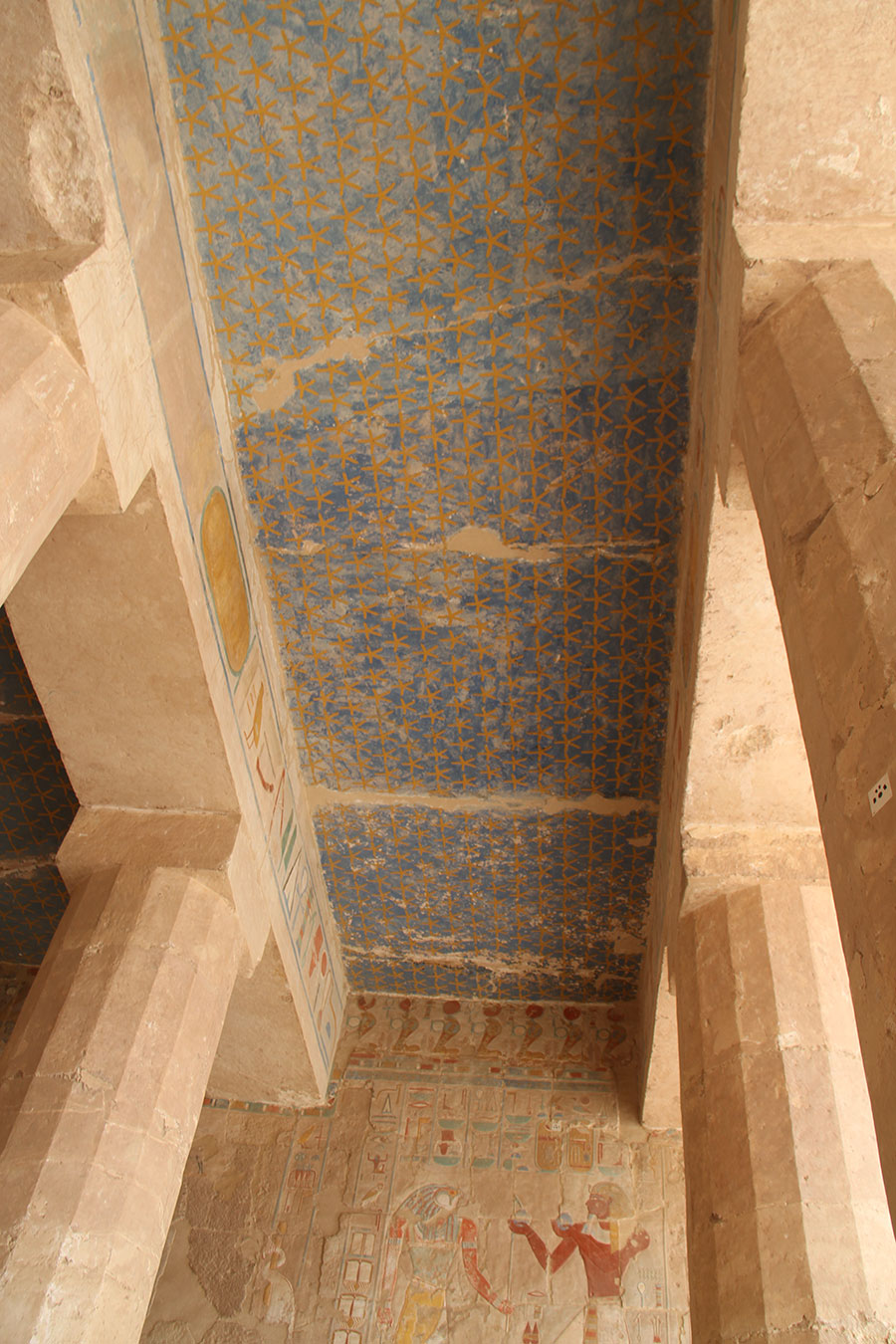


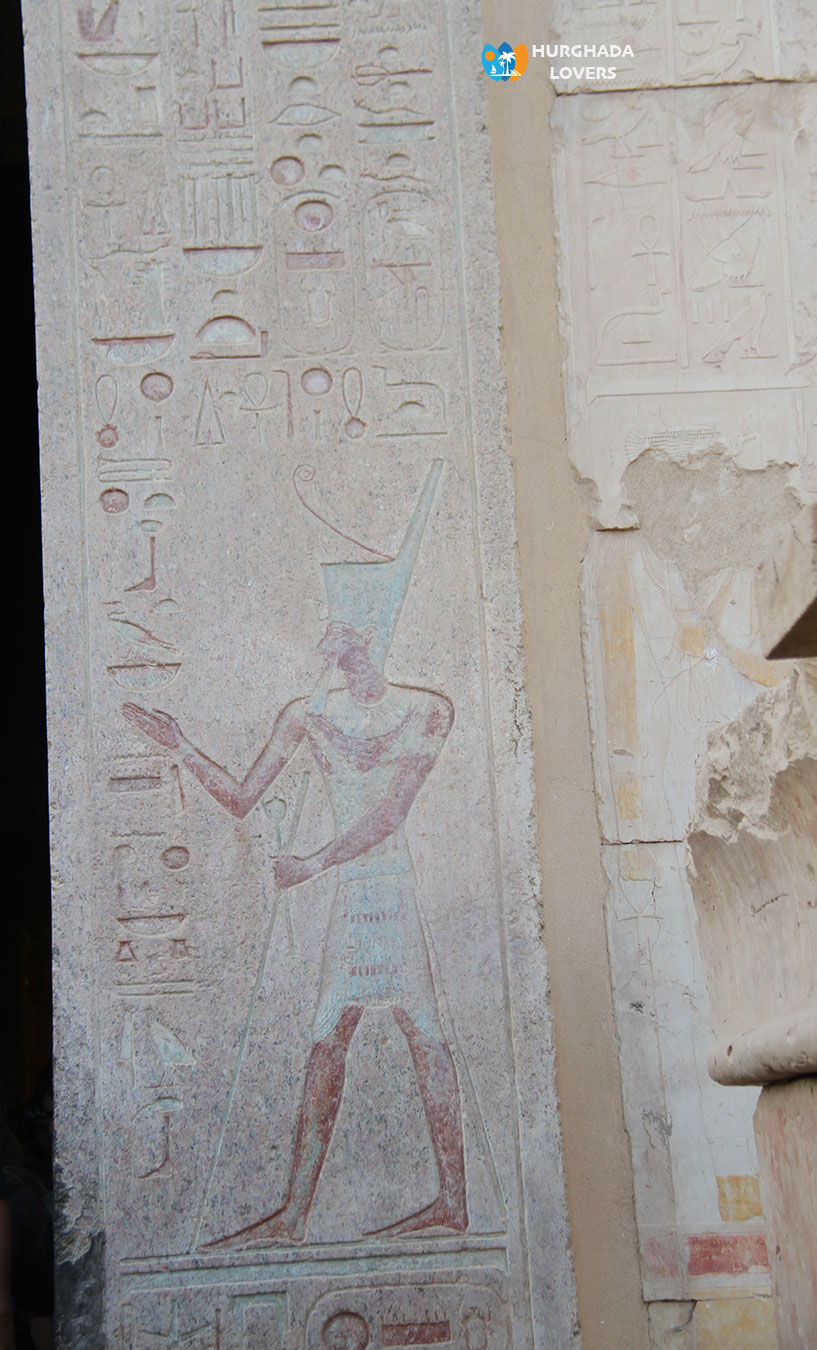
Mortuary Temple Of Hatshepsut Location:
Deir al-Bahari, Luxor, Egypt.
Temple of Hatshepsut Opening Hours:
Every Day From 06:00 AM To 05:00 PM.
Temple of Hatshepsut Entrance Fee 2024:
Foreigners:
Adults: EGP 360.
Student / Kids from 5-10 Years: EGP 180.
Egyptians/Arabs:
Adults: EGP 40.
Student / Kids from 5-10 Years: EGP 20.
FAQ:
Why is the Temple of Hatshepsut so important?
Because it tells us the secrets of the life of Queen Hatshepsut, one of the queens of the Eighteenth Dynasty, and the secret of her relationship with Samanut, and it is considered one of the most important funerary temples in the civilization of ancient Egypt.
What is unique about Hatshepsut temple?
- It tells us the secrets and daily lives of the ancient Egyptians, such as agriculture, industry, trade, livestock slaughter, and more.
- Unique and genius architectural design among the mountains.
Why was Hatshepsut’s temple destroyed?
King Thutmose III destroyed large parts of the temple in retaliation for Queen Hatshepsut after her death. Parts of the statues of Queen Hatshepsut were assembled in the form of the Sphinx and are currently located at the front of the temple.
Written by: Tamer Ahmed Abdel-Fattah | Tourism Expert | Best Tour Operator in Hurghada
Egyptian Monuments

